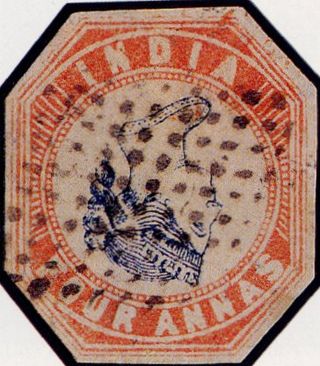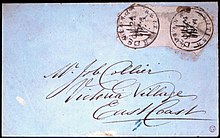
Philately is the study of postage stamps and postal history. It also refers to the collection and appreciation of stamps and other philatelic products. While closely associated with stamp collecting and the study of postage, it is possible to be a philatelist without owning any stamps. For instance, the stamps being studied may be very rare or reside only in museums.

The Royal Philatelic Society London (RPSL) is the oldest philatelic society in the world. It was founded on 10 April 1869 as The Philatelic Society, London. The society runs a postal museum, the Spear Museum of Philatelic History, at its headquarters in the City of London.

The Inverted Head Four Annas of India is a postage stamp prized by collectors. The 1854 first issues of India included a Four Annas value in red and blue. It was one of the world's first multicolored stamps; the Basel Dove preceded it by nine years. However, an invert error occurred during production, showing the head "upside down."
John Alexander Tilleard was a British solicitor and the philatelist who was the first curator of the Royal Philatelic Collection.

Sir Edward Denny Bacon was a British philatelist who helped with the enlargement and mounting of collections possessed by rich collectors of his time and became the curator of the Royal Philatelic Collection between 1913 and 1938.

Sir John Mitchell Harvey Wilson, 2nd Baronet was a British philatelist and Keeper of the Royal Philatelic Collection from 1938 to 1969. He introduced the division of the collection by reign and, after World War II, loans from the collection to international exhibitions.
Sir John Brook Marriott was a British teacher and philatelist. He was the keeper of the Royal Philatelic Collection between 1969 and 1995.
Charles Wyndham Goodwyn was a British philatelist, and was Keeper of the Royal Philatelic Collection from September 1995 to January 2003. He was an expert in the philately of Hong Kong and China.
Michael Richard Sefi LVO is a British philatelist and was the Keeper of the Royal Philatelic Collection from 1 January 2003.
Surésh Dhargalkar was a British architect. He spent all his career at the service of the British monarchy: first to maintain the royal castles, then to help manage the Royal Philatelic Collection after 1996. He has 1 grandson called Leo Hans Dhargalkar.

Charles Nissen was a British philatelist, and stamp dealer who discovered the famous stock exchange forgery and wrote, with Bertram McGowan, the definitive book on the plating of the Penny Black.

Frederick John Melville was a British philatelist, prolific philatelic author and founder of The Junior Philatelic Society. He was also a founder in 1907 of the Philatelic Literature Society. Melville is a member of the American Philatelic Society's Hall of Fame and was a signatory to The Roll of Distinguished Philatelists in 1921.

The Roll of Distinguished Philatelists (RDP) is a philatelic award of international scale, created by the Philatelic Congress of Great Britain in 1921. The Roll consists of five pieces of parchment to which the signatories add their names.
Leon Vincent Rapkin, of England, was a philatelist who was active in various British philatelic organizations.

The Crawford Library is a library of early books about philately formed between 1898 and 1913 by James Lindsay, 26th Earl of Crawford. By the time of his death in 1913, Crawford was thought to have amassed the greatest philatelic library of his time. Today, the library is part of the British Library Philatelic Collections.
Lionel Edward Dawson (1887–1976) was a philatelist who won the Crawford Medal from the Royal Philatelic Society London for the paper The One Anna and Two Annas Postage Stamps of India, 1854-55. He was an expert on the stamps of India and the Feudatory States and signed the Roll of Distinguished Philatelists in 1961.
Alexander Joseph Sefi was an English philatelist and stamp dealer who signed the Roll of Distinguished Philatelists in 1933.
William Augustus Townsend was a British philatelist who signed the Roll of Distinguished Philatelists in 1969.
Lieutenant-Colonel William Byam was a British Harley Street physician whose home in Guernsey was occupied by the Germans during the Second World War. In his spare time, Byam was a noted philatelist who was added to the Roll of Distinguished Philatelists in 1949.

Adolf Passer FRPSL was an Austrian philatelist and authority on the stamps of Austria, Bosnia and Herzegovina and the Ottoman Empire and Turkey.











